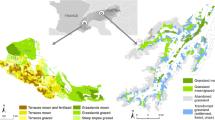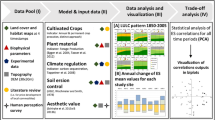Abstract
In this paper we take a fresh look at how to reach a predictable understanding of how rangelands work by viewing them as landscape systems3. What are the landscape structures and processes operating in rangelands that allow us to better understand how limited resources, such as water and soil nutrients, are naturally conserved within these systems? How can this understanding help us to better manage the use of rangelands so that degradation can be prevented? Can we distinguish between utilization and desertification? These kinds of questions can be addressed within a logical framework based on landscape ecology. This framework, labeled the trigger-transfer-reserve-pulse (TTRP) conceptual model, is built upon existing concepts applied to arid and semiarid, resource-limited rangelands. The TTRP framework focuses on how materials in short-supply such as water and soil nutrients (in sediments) are carried by runoff, or by winds, and are captured and concentrated within landscape patches (reserves). If the availability of these resources within a patch exceeds a critical threshold, a production ‘pulse’ occurs. The organic structures and materials produced in such pulses feedback to build on the integrity of landscape patches, and through them to the landscape as a whole, enabling them to capture more resources in the future. However, if patches are degraded by disturbances such as grazing, fewer scarce resources will be captured and landscapes can become dysfunctional. The relative ‘state’ of dysfunction for a rangeland unit can be measured and used to position the unit along a continuum of landscape functionality, from highly functional to highly dysfunctional. Whether this position on the continuum is acceptable for the current uses being made of the rangeland can then be evaluated. If an undesirable change in landscape functionality is detected by monitoring indicators on a unit of rangeland, then management recommendations and strategies can be developed to reverse this change by viewing the rangeland unit as a dynamic landscape system functioning to conserve resources.
Access this chapter
Tax calculation will be finalised at checkout
Purchases are for personal use only
Preview
Unable to display preview. Download preview PDF.
Similar content being viewed by others
Literature Cited
Anderson, V.I. and Hodgkinson, K.C. 1997. Grass-mediated capture of resource flows and the maintenance of banded mulga in a semi-arid woodland. Australian Journal of Botany 45, 331–342.
Committee on Developing Strategies for Rangeland Management. 1984. Developing Strategies for Rangeland Management. A Report Prepared by the Committee on Developing Strategies for Rangeland Management for the U.S. National Research Council and the National Academy of Sciences. Westview Press, Boulder, 2022 pp.
Dodd,.I.L. and Skinner, Q.D. 1990. Water harvesting and management in arid lands. In: Advances in Range Management in Arid Lands. Eds. R. Halwagy, F.K. Taha and S.A. Omar. pp. 101–112. Kegan Paul International, London.
Foran, B.D., Friedel, M., MacLeod, N.D., Stafford Smith, D.M. and Wilson, A.D. 1990. Policy Proposals for the Future of Australia’s Rangelands. Australian Government Publishing Service, Canberra.
Freudenberger, D., Noble, J. and Hodgkinson, K. 1997. Management for production and con- servation goals in rangelands. Chapter 8. In: Landscape Ecology, Function and Management: Principles from Australia’s Rangelands. Eds. J. Ludwig, D. Tongway, D. Freuden-berger, J. Noble and K. Hodgkinson. pp. 93–106. CSIRO Publishing, Melbourne.
Graetz, R.D. 1986. A comparative study of sheep grazing in a semi-arid saltbush pasture in two condition classes. Australian Rangeland Journal 8, 46–56.
Greene, R.S.B., Kinnell, P.I.A. and Wood, J.T. 1994. Role of plant cover and stock trampling on runoff and soil erosion from semi-arid wooded rangelands. Australian Journal of Soil Research 32, 953–973.
Gutierrez, J.R., DaSilva, O.A., Pagani, M.I., Weems, D. and Whitford, W.G. 1988. Effects of different patterns of supplemental water and nitrogen fertilization on productivity and composition of Chihuahuan Desert annual plants. American Midland Naturalist 119, 336–343.
Harrington, G.N., Dawes, G.T. and Ludwig, J.A. 1981. An analysis of the vegetation pattern in a semi-arid Eucalyptus populnea woodland in north-west New South Wales. Australian Journal of Ecology 6, 279–287.
Holmes, J.H. and Day, P. 1995. Identity, lifestyle and survival: value orientations of South Australian pastoralists. Rangeland Journal 17, 193–212.
Ludwig, J.A. and Freudenberger, D. 1997. Towards a sustainable future for rangelands. Chapter 10. In: Landscape Ecology, Function and Management: Principles from Australia’s Rangelands. Eds. J. Ludwig, D. Tongway, D. Freudenberger, J. Noble and K. Hodgkinson. pp. 121–131. CSIRO Publishing, Melbourne.
Ludwig, J.A. and Marsden, S.G. 1995. A simulation of resource dynamics within degraded semi-arid landscapes. Mathematics and Computers in Simulation 39, 219–224.
Ludwig, J.A. and Tongway, D.J. 1992. Monitoring the condition of Australian arid lands: linked plant-soil indicators. In: Ecological Indicators, Vol. 1. Eds. D.H. McKenzie, D.E. Hyatt and V.J. McDonald. pp. 765–772 Elsevier, Essex.
Ludwig, J.A. and Tongway, D.J. 1995. Spatial organisation of landscapes and its function in semi-arid woodlands, Australia. Landscape Ecology 10, 51–63.
Ludwig, J.A. and Tongway, D.J. 1996. Rehabilitation of semiarid landscapes in Australia. II. Restoring vegetation patches. Restoration Ecology 4, 398–406.
Ludwig, J.A. and Tongway, D.J. 1997. A landscape approach to rangeland ecology. Chapter 1. In: Landscape Ecology, Function and Management: Principles from Australia’s Rangelands. Eds. J. Ludwig, D. Tongway, D. Freudenberger, J. Noble and K. Hodgkinson. pp. 1–12. CSIRO Publishing, Melbourne.
Ludwig, J.A., Fargher, J.D., Foran, B.D., James, C.D., MacLeod, N.D. and McIntyre, S. 1996. Restoration of our earth’s rangelands: emergency damage control or faith in self-healing. In: Rangelands in a Sustainable Biosphere. Vol II. Proceedings of the Fifth International Rangeland Congress. Ed. N. West. pp. 65–71. Society of Range Management, Denver.
Ludwig, J., Tongway, D., Freudenberger, D., Noble, J. and Hodgkinson, K. (Eds.). 1997. Landscape Ecology, Function and Management: Principles from Australia’s Rangelands. CSIRO Publishing, Melbourne.
Ludwig, J.A., Tongway, D.J. and Marsden, S.G. 1994. A flow-filter model for simulating the conservation of limited resources in spatially heterogeneous, semi-arid landscapes. Pacific Conservation Biology 1, 209–213.
MacLeod, N.D. and Taylor, J.A. 1994. Perceptions of beef cattle producers and scientists relating to sustainable land use issues and their implications for technology transfer. Rangeland Journal 16, 238–253.
Milton, S.i., Dean, W.R.J., du Plessis, M.A. and Siegfried, W.R. 1994. A conceptual model of arid rangeland degradation: the escalating cost of declining productivity. BioScience 44, 70–76.
Noy-Meir, I. 1973. Desert ecosystems: environment and producers. Annual Review of Ecology and Systematics 4, 25–51.
Noy-Meir, I. 1981. Spatial effects in modelling of arid ecosystems. In: Arid-land Ecosystems: Structure, Functioning and Management, Vol. 2. Eds. D.W. Goodall and R.A. Perry. pp. 411–432. Cambridge University Press, Sydney.
Risser, P.G. 1987. Landscape ecology: state of the art. In: Landscape Heterogeneity and Disturbance. Ed. M.G. Turner. pp. 3–14. Springer-Verlag, New York.
Tongway, D.J. 1993. Functional analysis of degraded rangelands as a means of defining appropriate restoration techniques. In: Proceedings of the Fourth International Rangeland Congress. Eds. A. Gaston, M. Kernick and H. LeHouerou. pp. 166–168. Service Central d’Information Scientifique et Technique, Montpellier.
Tongway, D.J. 1994. Rangeland Soil Condition Assessment Manual. CSIRO Publishing, Melbourne.
Tongway, D.J. and Hindley, N. 1995. Manual for Soil Condition Assessment of Tropical Grasslands. CSIRO Wildlife and Ecology, Canberra.
Tongway, D.J. and Ludwig, J.A. 1990. Vegetation and soil patterning in semi-arid mulga lands of Eastern Australia. Australian Journal of Ecology 15, 23–34.
Tongway, D.J. and Ludwig, J.A. 1993. Rehabilitation of minesites and pastoral lands: the ecosystem function approach. In: Proceedings, Goldfields International Conference on Arid Landcare. pp. 51–57. Milean di Russo Pty Ltd., Hamilton Hill.
Tongway, D.J. and Ludwig, J.A. 1994. Small-scale resource heterogeneity in semi-arid landscapes. Pacific Conservation Biology 1, 201–208.
Tongway, D.I. and Ludwig, J.A. 1995. Function and dysfunction in mulga woodlands. In: Ecological Research and Management in the Mulgalands. Eds. M.i. Page and T.S. Beutel. pp. 85–89. University of Queensland Gatton College, Lawes.
Tongway, D.I. and Ludwig, J.A. 1996. Rehabilitation of semiarid landscapes in Australia. II. Restoring productive soil patches. Restoration Ecology 4, 388–397.
Tongway, D.J. and Ludwig, IA. 1997a. The conservation of water and nutrients within landscapes. Chapter 2. In: Landscape Ecology, Function and Management: Principles from Australia’s Rangelands. Eds. J. Ludwig, D. Tongway, D. Freudenberger, J. Noble and K. Hodgkinson. pp. 13–22. CSIRO Publishing, Melbourne.
Tongway, D.J. and Ludwig, J.A. 1997b. The nature of landscape dysfunction in rangelands. Chapter 5. In: Landscape Ecology. Function and Management: Principles from Australia’s Rangelands. Eds. J. Ludwig, D. Tongway, D. Freudenberger, J. Noble and K. Hodgkinson. pp. 49–61. CSIRO Publishing, Melbourne.
Turner, M.G. and Gardner, R.H. (Eds.) 1991. Quantitative Methods in Landscape Ecology - The Analysis and Interpretation of Landscape Heterogeneity. Springer-Verlag, New York.
Walker, B.H. 1996. Having or eating the rangeland cake: a developed world perspective on future options. In: Rangelands in a Sustainable Biosphere. Vol II. Proceedings of the Fifth International Rangeland Congress. Ed. N. West. pp. 22–28. Society of Range Management, Denver.
Whitford, W.G., Ludwig, J.A. and Noble. J.C. 1992. The importance of subterranean termites in semi-arid ecosystems in south-eastern Australia. Journal of Arid Environments 22, 87–91
Whitford, W.G., Reynolds, J.F. and Cunningham, G.L. 1987. How desertification affects nitrogen limitation of primary production on Chihuahuan Desert watersheds. In: Strategies for Classification and Management of Native Vegetation for Food Production in Arid Zones. Eds. E.F. Aldon, C.E. Gonzales Vicente and W.H. Moir. pp. 143–153. General Technical Report RM-150. U.S. Department of Agriculture, Forest Service, Rocky Mountain Forest and Range Experiment Station, Fort Collins.
Williams, M., McCarthy, M. and Pickup, G. 1995. Desertification, drought and landcare: Australia’s role in an international convention to combat desertification. Australian Geographer 26, 23–32.
Young, M.D., Gibbs, M., Holmes, W.E. and Mills, D.M.D. 1984. Socio-economic influences on pastoral management. In: Management of Australia’s Rangelands. Eds. G.N. Harrington, A.D. Wilson and M.D. Young. pp. 79–93. CSIRO Publishing, Melbourne.
Author information
Authors and Affiliations
Editor information
Rights and permissions
Copyright information
© 2000 Springer Science+Business Media Dordrecht
About this chapter
Cite this chapter
Ludwig, J.A., Tongway, D.J. (2000). Viewing rangelands as landscape systems. In: Arnalds, O., Archer, S. (eds) Rangeland Desertification. Advances in Vegetation Science, vol 19. Springer, Dordrecht. https://doi.org/10.1007/978-94-015-9602-2_4
Download citation
DOI: https://doi.org/10.1007/978-94-015-9602-2_4
Publisher Name: Springer, Dordrecht
Print ISBN: 978-90-481-5359-6
Online ISBN: 978-94-015-9602-2
eBook Packages: Springer Book Archive




